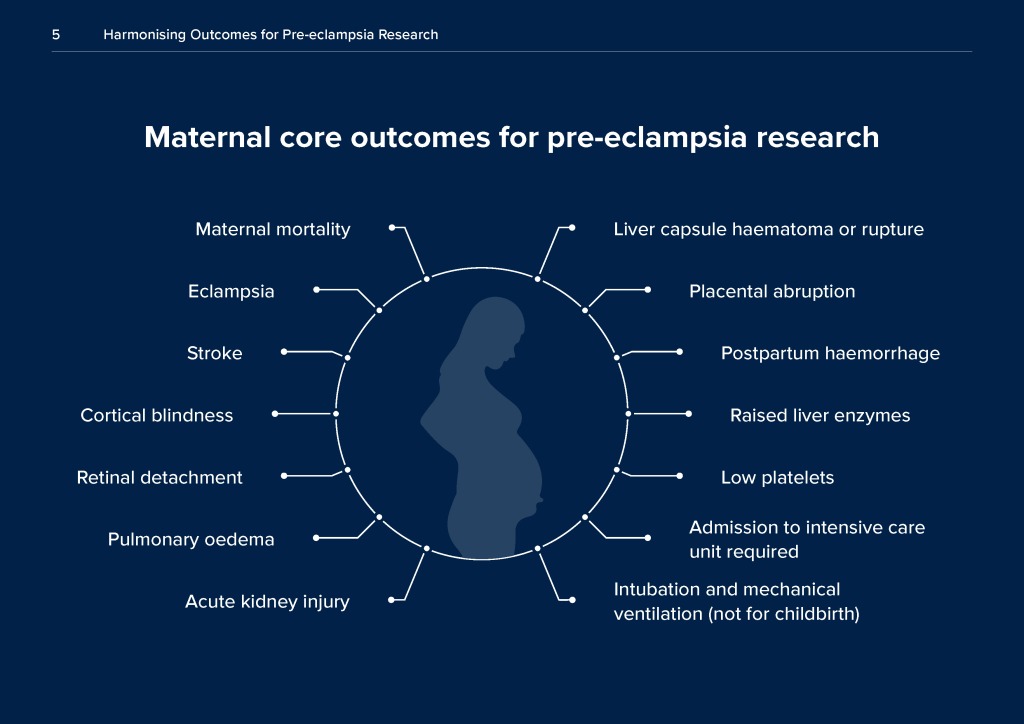
What we need to know about Pre-eclampsia:
Pre-eclampsia is a dangerous pregnancy related complication characterised by maternal high blood pressure which mainly occurs after 20 weeks of pregnancy and is very hazardous to both the mother and the baby. Pre-eclampsia is one of the leading causes of maternal and perinatal morbidity and mortality.
Eclampsia happens to any woman during the second half of her pregnancy, or up to six weeks after delivery. Diagnosing Pre-eclampsia early is very important for both mothers and their babies. If you are pregnant and experiencing symptoms or just feel not right, contact your healthcare providers right away
KNOW THE FACTS
| Affects up to 10% of pregnancies world wide | A leading cause of maternal and infant deaths with 76,000 maternal and 500,000 infant deaths each year globally | Over 90% of pregnancy-related deaths occur in low-to-middle income countries | Common factor in preterm delivery accounts for 20% of all neonatal intensive care admissions. |
| Results in 16% maternal deaths in low-to-middle income countries | Accounts for ¼ of maternal deaths in Latin America and 1/10 of maternal deaths in Africa | Risk of end stage renal disease in women with pre-eclampsia is 3 to 5 times higher than in women who did not have pre-eclampsia | Affects up to 6% of pregnancies in the post-partum period |
In Uganda, 11% of all maternal deaths are caused by pre-eclampsia related conditions accounting for 550 maternal mortalities and 1000 women die in Kawempe maternal hospital 3 months after birth.
Pre-eclampsia remains are tricky condition not known to very many. Very few mothers and their care takers can always promptly tell or distinguish the signs and symptoms of Pre-eclampsia from the normal pregnancy related changes.There is need to sensitize mothers during their medical visits not forgetting the communities they always interact with inorder to save lives of mothers by prompting quick actions and reactions towards pre-eclampsia.
Pregnancy related signs and symptoms are far different from those triggered by pre-eclampsia .It is crucial to monitor your pregnancy for signs and symptoms of pre-eclampsia as shown below;
Signs and symptoms of pre-eclampsia
- Elevated blood pressure
- Elevated proteinuria
- Excessive weight gain of more than 5 pounds in a week
- Swelling of hands, feet and the Face
- Severe persistent Headaches and chest pain that won’t go away even with medication
- Blurred Vision or changes in vision (spots, light flashes or vision loss)
- Difficulty in breathing, gasping or panting.
- Nausea after mid pregnancy
- Upper right belly pain.
- Severe pain under the ribs
- Feeling unwell

The term pre-eclampsia includes related hypertension disorders of pregnancy which may not be distinguishable from pre-eclampsia. Early detection and quick interventions are strongly needed to sweep away the risks associated with pre-eclampsia. The earlier you identify women at high risk for Pre-eclampsia, the better the outcomes for mother and child.
Associated Risks!!!
MOTHER BABY
- Seizures Premature births
- Water in the lungs Low birth weight
- Stroke Stunting
- Deaths Deaths

Effects of pre-eclampsia to babies

Many communities cannot clearly tell the cause of pre-eclampsia which has caused many people to get get wicked thoughts including attributing its causes as unclear disorders in a pregnant Woman.
These myths and misconceptions like attributing Pre-eclampsia to witch craft and also blaming it to involvement in extra marital affairs during pregnancy (Adultery) has caused a lot of maternal deaths due to late detection and prolonged and late referrals.
Sensitization of the public about the manifestations and interventions to be taken in case of pre-elampsia is key in curbing pre-eclampsia related maternal deaths.
WHAT TO DO (Mothers level)
DURING PREGNANCY
- Mothers should always seek medical care and frequently talking to their health care providers before or early in pregnancy about the risks of pre-eclampsia.
- Knowing your family history especially for pregnancy, high blood pressure and diabetes
- Mothers should attend all their prenatal visits(ANC)
AFTER DELIVERY (POST NATAL PERIOD)
- Mothers should monitor their blood pressure and weight regularly and always seek medical attention in case of sharp and erratic changes
Eat right, exercise regularly and maintain a healthy weight.
WHAT TO DO (SERVICE DELIVERY)
- Governments should invest in training more health workers in specialised pre-eclampsia management to bridge the knowledge gaps.
- The government should invest so much in availing medicines of choice which help in treating pre-eclampsia up to the lower health centres which receive most of these mothers
The medicines of choice in the treatment of pre-eclampsia include Magnesium sulphate ( It should be noted that it’s not always easy to administer this drug and special attentions needs to be given plus reassuring of the mother), Hypertensive drugs like methyldopa, and calcium gluconate among others.
- Sensitization of the general public about the signs and symptoms of pre-eclampsia and also creating massive awareness at all levels to mitigate the risks associated with late referrals and detections.
- Training and screening at the lowest levels of the health care systems
- Empowering women with good health Behaviours and encouraging male involvement.
- Developing of alternatives medicines to replace the highly painful Magnesium sulphate which inflict serious side effects on a lady.
NEEDED ACTIONS!
1.Push for a comprehensive Universal health systems Approach.
2. Provider education 3.Consistent adherence to clinical guidelines 4. Referral pathways
WHAT TO ADDRESS ?
- Work force shortages
- Availability of essential drugs
- Gaps in governance and financing
References.
- FIGO pre-eclampsia guidelines 2019
- USAID/ International society for the study of hypertension in pregnancy; pre-eclampsia Foundation.

SRHR Advocate
Program Manager, Womens Health Foundation-Uganda
+256700326882
saavaben@gmail.com